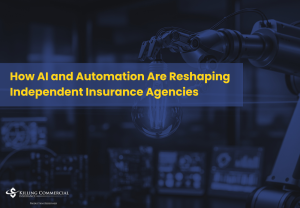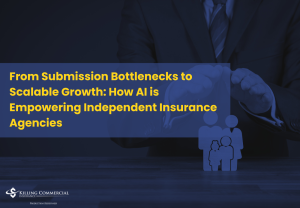From High Deductible Workers’ Comp to Scalable Growth: How Insurance Agency Can Leverage Alternative Risk, Virtual Teams, and Marketing Automation – A Conversation with Eric Stein

The commercial insurance industry is undergoing a transformation, especially for agencies working in the middle market. As traditional models face increasing pressure from rate hikes, market consolidation, and technology shifts, savvy agency owners and producers are finding new ways to grow, scale, and protect their margins.
Three key strategies are rising to the top: implementing alternative workers’ compensation programs, building virtual insurance teams, and using marketing automation to create sustainable lead pipelines.
In this post, we’ll walk through each of these pillars and share real-world insights on how to incorporate them into your agency. Whether you’re an agency principal, sales leader, or producer, this blueprint will help you adapt to modern challenges while building long-term value.
Understanding the Landscape of Workers' Compensation Alternatives
Workers’ compensation insurance is often one of the largest cost centers for businesses—making it a huge opportunity for agents who know how to position alternatives to guaranteed cost programs. But there’s a big gap between knowing the lingo and actually helping a client transition into more complex risk financing.
Before jumping into captives, it’s critical to understand the stepping stones:
- Guaranteed Cost: The most basic structure. Clients pay a fixed premium regardless of losses.
- Retro Plans: A hybrid model where the client’s final premium adjusts based on losses.
- High Deductible Programs: Clients retain more risk upfront, often requiring significant collateral.
- Captive Insurance: Self-insurance models where the client becomes the carrier and assumes full or partial risk.
“Captives are not something you dabble in. You either do them or you don’t.” – David Carothers
When Is a Client Ready for a Captive?
Captives are not for everyone. They’re best suited for financially stable companies with strong risk management practices and the ability to commit capital long term. Many agents make the mistake of recommending a captive purely to save on premium—without considering whether the business has the operational infrastructure to support it.
Instead, producers should guide clients through a gradual risk transition, often starting with a high deductible workers’ compensation program. This not only prepares the client but also provides a proving ground for how well they can manage claims and safety protocols.
“You’re not a broker anymore. You have to run it like an insurance carrier.” – Eric Stein

Building a Risk Management-Centric Sales Strategy
Clients that thrive in alternative comp programs are the ones who treat risk management as a priority, not an afterthought. That’s why producers need to shift their positioning from “insurance seller” to “trusted risk advisor.”
To be successful, your agency should help clients implement:
- Return-to-work programs
- Injury triage and nurse hotlines
- Field-level safety training
- Custom risk assessments
- Actuarial support for setting realistic loss picks
These strategies don’t just reduce claims—they also allow clients to retain more risk with confidence, opening the door for self-insurance, captives, or risk-sharing pools down the road.
Scaling Operations with Virtual Assistants in Insurance
Scaling an insurance agency doesn’t always mean hiring more people in-house. In fact, many successful agencies are doing the opposite: building hybrid teams using virtual assistants and remote professionals to handle repetitive and operational tasks.
“My mantra was outsource and automate.” – Eric Stein
Eric Stein, founder of Insured Solutions, scaled his agency by outsourcing tasks to offshore teams in India and the Philippines as early as 2009. While many agencies are just now exploring the use of remote insurance professionals, Stein was already using VAs to handle back-office operations, appointment setting, and data entry.
Where to Start with Virtual Assistants
If you’re just getting started with outsourcing, consider offloading the following:
- Submission entry into CRMs or agency management systems
- Quote requests and carrier follow-ups
- Renewal preparation
- COI requests
- Appointment setting and lead generation
“You have to treat virtual professionals like real employees—train them, support them, and manage them like your in-house team.” – David Carothers
The key is to pair your virtual team with a U.S.-based point of contact who can supervise, handle feedback, and resolve issues quickly. This keeps your domestic staff focused on client experience and selling—while the VAs take care of the heavy lifting.
Documenting Workflows: Your Key to Offshore Success

Many agencies fail with virtual teams not because the people are unqualified, but because there are no documented workflows in place. This leads to confusion, errors, and frustration.
Here’s how to fix that:
- Use tools like Tango to record your screen as you perform tasks. It generates step-by-step guides with screenshots automatically.
- Supplement with Loom videos for visual learners.
- Store all resources in a Learning Management System (LMS) so your new hires can self-train over 30–90 days.
- Start with 1–2 offshore team members and build from there.
“If you’re handing someone a script and a call list with no process or feedback loop, you’re setting them up to fail.” – David Carothers
Lead Generation at Scale with Marketing Automation
If your producers are spending all their time chasing cold leads or begging for referrals, you’ve got a lead problem—not a sales problem.
That’s where marketing automation becomes a game-changer.
What Marketing Automation Can Do for You
- Drip campaigns to warm up cold prospects
- Lead scoring to prioritize follow-up
- Nurture sequences based on behavior
- Integration with CRMs for real-time engagement
- Scalable outreach across email, social media, and SMS
“I built a lead engine where producers didn’t have to cold call. Appointments came in through automation, telemarketing, and email.” – Eric Stein
Stein started small, testing email blasts to a few hundred contacts. Once the messaging worked, he scaled to over 80,000 contacts at the push of a button. Today, platforms like AgencyZoom, HubSpot, and GoHighLevel make it easier than ever to automate campaigns without breaking the bank.
Leveraging Cost Efficiency to Attract Top Talent
One unexpected benefit of outsourcing and automation? You get the margin flexibility to pay top dollar for top talent.
Eric Stein used offshore teams to save on labor and then reinvested those savings into six-figure salaries for producers, underwriters, and CSRs. That allowed him to recruit people who wouldn’t have considered a startup or boutique agency otherwise.
It also enabled him to scale fast without bloating overhead, a crucial factor in eventually selling part of his firm to private equity.
Final Thoughts: Are You Ready to Evolve?
This isn’t about shiny objects or fads—it’s about adapting to the modern insurance marketplace. If you’re serious about scaling your agency, protecting your margins, and building something that lasts, the combination of alternative risk strategies, virtual teams, and automation is a playbook worth following.
Before you jump in, ask yourself:
- Do we have documented workflows for every core process?
- Are we building a proactive risk management culture?
- Can we train and manage remote professionals effectively?
- Is our lead generation predictable and scalable?
If the answer is no to any of these, you’ve got work to do. But the good news is, the roadmap exists—and with the right focus, your agency can thrive in today’s evolving market.

How AI and Automation Are Reshaping Independent Insurance Agencies
In an industry where tradition often outweighs innovation, artificial intelligence and automation are slowly but steadily reshaping how independent insurance agencies operate. The push toward smarter, more efficient workflows is no longer a matter of if—but when. While many agencies are still evaluating how AI fits into their operations, early adopters are already reaping the benefits of streamlined submissions, faster processing, and actionable data insights.

Coaching, Competition, and Consolidation: Inside the Protege Mindset That’s Reshaping the Future of Insurance Producers
The commercial insurance industry is changing faster than ever—and not always for the better. Consolidation is accelerating. Service levels are declining. Private equity is pushing agencies to scale in ways that strip out the personal touch that once defined the independent channel. But for the producers willing to do the work, lean into mentorship, and sharpen their craft, this isn’t a challenge—it’s an opportunity.

From Submission Bottlenecks to Scalable Growth: How AI is Empowering Independent Insurance Agencies
The commercial insurance industry is in the midst of a major evolution. The traditional workflows that once drove agency productivity are now dragging down growth, overloading staff, and frustrating owners who are trying to scale efficiently. For independent insurance agencies—especially those in the middle market—adapting to these challenges without increasing overhead is a tightrope walk.

The Power of Patient Prospecting: How Education, Niching, and Mindset Drive Middle-Market Success
Few industries reward consistency, discipline, and patience quite like middle-market commercial insurance. Initially, every producer starts with a different story, background, and path into the business. However, the ones who rise are the ones who learn to embrace the long game. Moreover, while success may take time, those who persevere ultimately reap the benefits. Furthermore, this industry values resilience, and those who remain committed often find themselves achieving great success in the end.

Reclaiming Purpose in a Distracted World: Empowerment, Emotional Intelligence, and the Future of Work-Life Balance
In today’s performance-obsessed culture, achieving elite status in your profession can often come with a hidden price. Tania Khazaal, known to many as Tanya the Herbalist, knows this truth firsthand. After climbing the ranks in the insurance industry and landing in the top 1% of sales professionals, she found herself at a crossroads. Despite the accolades, international travel perks, and consistent recognition, she was suffering from a quiet crisis: burnout.

From Confusion to Clarity: How Insurance Agencies Can Unlock Growth Through Strategic Leadership and Culture
In the fast-paced world of commercial insurance, the grind of daily operations often blinds agency leaders to the foundational cracks forming beneath them. Producers are focused on closing deals. Account managers are buried in servicing. Agency principals are juggling leadership, sales, operations, and finance. Yet in the midst of this hustle, many agencies lack the one thing that can unlock the next level of growth: organizational clarity.

Responses